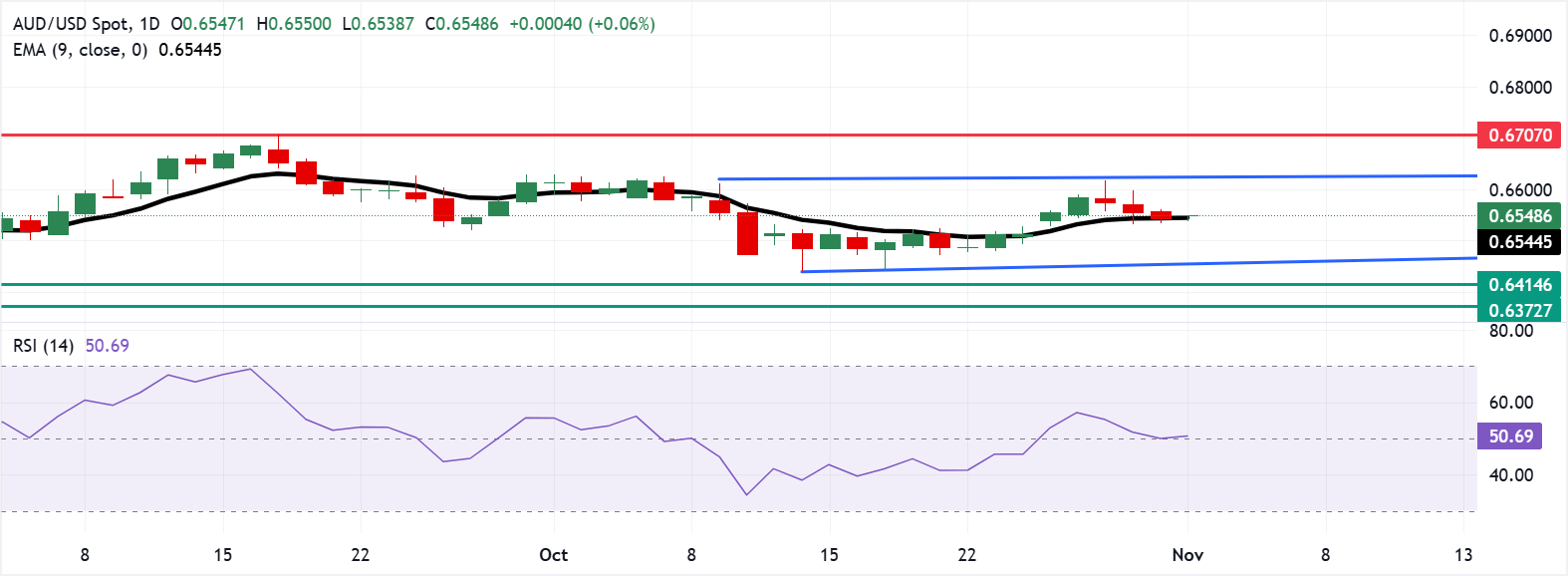Australian Dollar holds losses following China's RatingDog Manufacturing PMI data
- Australian Dollar struggles as TD-MI Inflation Gauge climbed 0.3% MoM in October, against a 0.4% gain in September.
- China's RatingDog Manufacturing Purchasing Managers' Index fell to 50.6 in October from 51.2 in September.
- The US Dollar strengthens as expectations for a December Fed rate cut fade.
Australian Dollar (AUD) declines against the US Dollar (USD) for the fourth successive session on Monday. The AUD/USD pair remains subdued as the US Dollar (USD) gains amid dampening expectations of a US Federal Reserve (Fed) interest rate cut in December.
The AUD is trading lower following the release of economic data from Australia and China. The TD-MI Inflation Gauge rose 0.3% month-on-month (MoM) in October, easing slightly from a 0.4% gain in September but marking the second consecutive monthly increase. Meanwhile, the annual Inflation Gauge rose 3.1%, edging higher from the previous 3.0%.
Australia’s Building Permits rose 12.0% MoM, after falling 3.6% in August and beating market expectations of a 5.5% growth. ANZ Job Advertisements fell 2.2% month-on-month in October, following a revised 3.5% drop in the previous month. This marked the fourth straight monthly decline.
China's RatingDog Manufacturing Purchasing Managers' Index (PMI) declined to 50.6 in October from 51.2 in September. The market forecast was for a 50.9 print. It is important to note that any shift in China’s economic conditions could also affect the Australian dollar (AUD), given the close trade ties between China and Australia.
Traders turned cautious ahead of Tuesday’s RBA policy decision, with the bank expected to hold rates after three earlier cuts, as Q2 headline and trimmed mean inflation stayed within the 2–3% target range.
US Dollar gains ground due to weakening likelihood of Fed rate cuts
- The US Dollar Index (DXY), which measures the value of the US Dollar (USD) against six major currencies, is gaining ground and trading around 99.80 at the time of writing. The US ISM Manufacturing Purchasing Managers Index (PMI) report is due later on Monday.
- Fed funds futures traders are now pricing in a 69% chance of a cut in December, down from 93% a week ago, according to the CME FedWatch Tool.
- Fed Chair Jerome Powell said during the post-meeting press conference that another rate cut in December is far from certain. Powell also cautioned that policymakers may need to take a wait-and-see approach until official data reporting resumes.
- The US Fed delivered a 25-basis-point rate cut on Wednesday, lowering its benchmark rate to a range of 3.75%–4.0% in a 10–2 vote. The decision was not unanimous, as Fed Governor Stephen Miran supported a larger 50-basis-point cut, while Kansas City Fed President Jeffrey Schmid voted to keep rates unchanged.
- Traders may adopt caution due to the prolonged government shutdown, which could fuel economic concerns in the United States (US). The US government impasse has now entered its sixth week with no easy endgame in sight amid a deadlock in Congress on the Republican-backed funding bill.
- China’s NBS Manufacturing Purchasing Managers' Index dropped sharply to 49.0 in October, following 49.8 recorded in September. The reading came in above the expected 49.6 figure in the reported month. Meanwhile, the NBS Non-Manufacturing PMI unexpectedly rose slightly to 50.1 against the previous and the market consensus of 50.0 readings.
- The RBA Trimmed Mean CPI for Q3 rose 1.0% and 3.0% on a quarterly and annual basis, respectively. Markets estimated an increase of 0.8% QoQ and 2.7% YoY in the quarter to September. The monthly Consumer Price Index jumped by 3.5% YoY in August, compared to the previous reading of a 3.0% increase. This figure came in hotter than the expectation of 3.1%.
- Australia’s hotter-than-expected Q3 inflation and August CPI data reduced expectations for near-term rate cuts by the Reserve Bank of Australia (RBA). RBA Governor Bullock noted that the labor market remains somewhat tight, despite the unexpected rise in the unemployment rate.
Australian Dollar hovers around 0.6550 as consolidation prevails
The AUD/USD pair is trading around 0.6550 on Monday. Technical analysis of a daily chart suggests a consolidation phase as the pair moves sideways within a rectangle pattern. However, the pair is positioned slightly above the nine-day Exponential Moving Average (EMA), indicating that short-term price momentum is stronger.
The initial barrier lies at the psychological level of 0.6600, followed by the rectangle’s upper boundary around 0.6630. Further advances above the rectangle would signal a bullish bias and support the AUD/USD pair in exploring the region around the 13-month high of 0.6707, recorded on September 17.
On the downside, the primary support lies at the nine-day EMA of 0.6544. A break below this level would weaken the short-term price momentum and prompt the AUD/USD pair to navigate the region around the lower boundary of the rectangle around 0.6460, followed by the five-month low of 0.6414.
AUD/USD: Daily Chart

Economic Indicator
RatingDog Manufacturing PMI
The RatingDog Manufacturing Purchasing Managers Index (PMI), released on a monthly basis by Caixin Insight Group and S&P Global, is a leading indicator gauging business activity in China’s manufacturing sector. The data is derived from surveys of senior executives at both private-sector and state-owned companies. Survey responses reflect the change, if any, in the current month compared to the previous month and can anticipate changing trends in official data series such as Gross Domestic Product (GDP), industrial production, employment and inflation.The index varies between 0 and 100, with levels of 50.0 signaling no change over the previous month. A reading above 50 indicates that the manufacturing economy is generally expanding, a bullish sign for the Renminbi (CNY). Meanwhile, a reading below 50 signals that activity among goods producers is generally declining, which is seen as bearish for CNY.
Read more.Last release: Mon Nov 03, 2025 01:45
Frequency: Monthly
Actual: 50.6
Consensus: 50.9
Previous: 51.2
Source: IHS Markit

